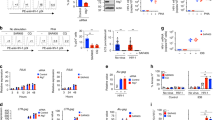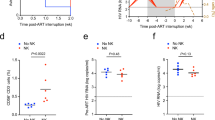Abstract
Targeting viral entry is the most likely gene therapy strategy to succeed in protecting the immune system from pathogenic HIV-1 infection. Here, we evaluated the efficacy of a gene transfer lentiviral vector expressing a combination of viral entry inhibitors, the C46 peptide (an inhibitor of viral fusion) and the P2-CCL5 intrakine (a modulator of CCR5 expression), to prevent CD4+ T-cell infection in vivo. For this, we used two different models of HIV-1-infected mice, one in which ex vivo genetically modified human T cells were grafted into immunodeficient NOD.SCID.γc−/− mice before infection and one in which genetically modified T cells were derived from CD34+ hematopoietic progenitors grafted few days after birth. Expression of the transgenes conferred a major selective advantage to genetically modified CD4+ T cells, the frequency of which could increase from 10 to 90% in the blood following HIV-1 infection. Moreover, these cells resisted HIV-1-induced depletion, contrary to non-modified cells that were depleted in the same mice. Finally, we report lower normalized viral loads in mice having received genetically modified progenitors. Altogether, our study documents that targeting viral entry in vivo is a promising avenue for the future of HIV-1 gene therapy in humans.
This is a preview of subscription content, access via your institution
Access options
Subscribe to this journal
Receive 12 print issues and online access
$259.00 per year
only $21.58 per issue
Buy this article
- Purchase on Springer Link
- Instant access to full article PDF
Prices may be subject to local taxes which are calculated during checkout




Similar content being viewed by others
References
Martinson JJ, Chapman NH, Rees DC, Liu YT, Clegg JB . Global distribution of the CCR5 gene 32-basepair deletion. Nat Genet 1997; 16: 100–103.
Allers K, Hütter G, Hofmann J, Loddenkemper C, Rieger K, Thiel E et al. Evidence for the cure of HIV infection by CCR5Δ32/Δ32 stem cell transplantation. Blood 2011; 117: 2791–2799.
Holt N, Wang J, Kim K, Friedman G, Wang X, Taupin V et al. Human hematopoietic stem/progenitor cells modified by zinc-finger nucleases targeted to CCR5 control HIV-1 in vivo. Nat Biotechnol 2010; 28: 839–847.
Didigu CA, Wilen CB, Wang J, Duong J, Secreto AJ, Danet-Desnoyers GA et al. Simultaneous zinc-finger nuclease editing of the HIV coreceptors ccr5 and cxcr4 protects CD4+ T cells from HIV-1 infection. Blood 2014; 123: 61–69.
Perez EE, Wang J, Miller JC, Jouvenot Y, Kim KA, Liu O et al. Establishment of HIV-1 resistance in CD4+ T cells by genome editing using zinc-finger nucleases. Nat Biotechnol 2008; 26: 808–816.
Tebas P, Stein D, Tang WW, Frank I, Wang SQ, Lee G et al. Gene editing of CCR5 in autologous CD4 T cells of persons infected with HIV. N Engl J Med 2014; 370: 901–910.
Peterson CW, Younan P, Jerome KR, Kiem H-P . Combinatorial anti-HIV gene therapy: using a multipronged approach to reach beyond HAART. Gene Ther 2013; 20: 695–702.
Colin P, Bénureau Y, Staropoli I, Wang Y, Gonzalez N, Alcami J et al. HIV-1 exploits CCR5 conformational heterogeneity to escape inhibition by chemokines. Proc Natl Acad Sci USA 2013; 110: 9475–9480.
Greenberg ML, Cammack N . Resistance to enfuvirtide, the first HIV fusion inhibitor. J Antimicrob Chemother 2004; 54: 333–340.
Von Laer D, Hasselmann S, Hasselmann K . Gene therapy for HIV infection: what does it need to make it work? J Gene Med 2006; 8: 658–667.
Doitsh G, Galloway NLK, Geng X, Yang Z, Monroe KM, Zepeda O et al. Cell death by pyroptosis drives CD4 T-cell depletion in HIV-1 infection. Nature 2014; 505: 509–514.
Heredia A, Gilliam B, DeVico A, Le N, Bamba D, Flinko R et al. CCR5 density levels on primary CD4 T cells impact the replication and Enfuvirtide susceptibility of R5 HIV-1. Aids 2007; 21: 1317–1322.
Anastassopoulou CG, Ketas TJ, Sanders RW, Klasse PJ, Moore JP . Effects of sequence changes in the HIV-1 gp41 fusion peptide on CCR5 inhibitor resistance. Virology 2012; 428: 86–97.
Petit N, Dorgham K, Levacher B, Burlion A, Gorochov G, G Marodon . Targeting both viraland host determinants of human immunodeficiency virus entry, using a new lentiviral vector coexpressing the T20 fusion inhibitor and a selective CCL5 intrakine. Hum Gene Ther Methods 2014; 25: 232–240.
Hartley O, Dorgham K, Perez-Bercoff D, Cerini F, Heimann A, Gaertner H et al. Human immunodeficiency virus type 1 entry inhibitors selected on living cells from a library of phage chemokines. J Virol 2003; 77: 6637–6644.
Schroers R, Davis CM, Wagner HJ, Chen SY . Lentiviral transduction of human T-lymphocytes with a RANTES intrakine inhibits human immunodeficiency virus type 1 infection. Gene Ther 2002; 9: 889–897.
Egelhofer M, Brandenburg G, Martinius H, Schult-Dietrich P, Melikyan G, Kunert R et al. Inhibition of human immunodeficiency virus type 1 entry in cells expressing gp41-derived peptides. J Virol 2004; 78: 568–575.
Kimpel J, Braun SE, Qiu G, Wong FE, Conolle M, Schmitz JE et al. Survival of the fittest: positive selection of CD4+ T cells expressing a membrane-bound fusion inhibitor following HIV-1 infection. PLoS One 2010; 5: e12357.
Burke BP, Levin BR, Zhang J, Sahakyan A, Boyer J, Carroll MV et al. Engineering cellular resistance to HIV-1 infection in vivo using a dual therapeutic lentiviral vector. Mol Ther Acids 2015; 4: e236.
Trobridge GD, Wu RA, Beard BC, Chiu SY, Muñoz NM, von Laer D et al. Protection of stem cell-derived lymphocytes in a primate AIDS gene therapy model after in vivo selection. PLoS One 2009; 4: e7693.
King MA, Covassin L, Brehm MA, Racki W, Pearson T, Leif J et al. Human peripheral blood leucocyte non-obese diabetic-severe combined immunodeficiency interleukin-2 receptor gamma chain gene mouse model of xenogeneic graft-versus-host-like disease and the role of host major histocompatibility complex. Clin Exp Immunol 2009; 157: 104–118.
Younan PM, Polacino P, Kowalski JP, Peterson CW, Maurice NJ, Williams NP et al. Positive selection of mC46-expressing CD4+ T cells and maintenance of virus specific immunity in a primate AIDS model. Blood 2013; 122: 179–187.
Shimizu S, Ringpis G-E, Marsden MD, Cortado RV, Wilhalme HM, Elashoff D et al. RNAi-mediated CCR5 knockdown provides HIV-1 resistance to memory T cells in humanized BLT mice. Mol Ther Nucleic Acids 2015; 4: e227.
Myburgh R, Ivic S, Pepper MS, Gers-Huber G, Li D, Audigé A et al. Lentivector knock-down of CCR5 in hematopoietic stem cells confers functional and persistent HIV-1 resistance in humanized mice. J Virol 2015; 89: 6761–6772.
Walker JE, Chen RX, McGee J, Nacey C, Pollard RB, Abedi M et al. Generation of an HIV-1-resistant immune system with CD34+ hematopoietic stem cells transduced with a triple-combination anti-HIV lentiviral vector. J Virol 2012; 86: 5719–5729.
De Ravin SS, Gray JT, Throm RE, Spindler J, Kearney M, Wu X et al. False-positive HIV PCR test following ex vivo lentiviral gene transfer treatment of X-linked severe combined immunodeficiency vector. Mol Ther 2014; 22: 244–245.
Abarrategui-Pontes C, Créneguy A, Thinard R, Fine EJ, Thepenier V, Fournier LRL et al. Codon swapping of zinc finger nucleases confers expression in primary cells and in vivo from a single lentiviral vector. Curr Gene Ther 2014; 14: 365–376.
DiGiusto DL, Krishnan A, Li L, Li H, Li S, Rao A et al. RNA-based gene therapy for HIV with lentiviral vector-modified CD34(+) cells in patients undergoing transplantation for AIDS-related lymphoma. Sci Transl Med 2010; 2: 36ra43.
Podsakoff GM, Engel BC, Carbonaro DA, Choi C, Smogorzewska EM, Bauer G et al. Selective survival of peripheral blood lymphocytes in children with HIV-1 following delivery of an anti-HIV gene to bone marrow CD34+ cells. Mol Ther 2005; 12: 77–86.
Zufferey R, Dull T, Mandel RJ, Bukovsky A, Quiroz D, Naldini L et al. Self-inactivating lentivirus vector for safe and efficient in vivo gene delivery. J Virol 1998; 98: 9873–9880.
Marodon G, Mouly E, Blair EJ, Frisen C, Lemoine FM, Klatzmann D . Specific transgene expression in human and mouse CD4+ cells using lentiviral vectors with regulatory sequences from the CD4 gene. Blood 2003; 101: 3416–3423.
Acknowledgements
This work was supported by grants from Agence Nationale de la Recherche contre le SIDA (ANRS) to Guy Gorochov and Gilles Marodon. NYP was supported by a doctoral fellowship from Fond Pierre Bergé/SIDAction and by the ANRS. We thank David Klatzmann (INSERM U959, Paris, France) for his initial support on this project, Dorothée van Laer (Innsbruck University, Austria) for the kind gift of the C46 peptide, Arnaud Moris (CIMI-PARIS, France) for the kind gift of NL-AD8 HIV-1 strain, Dr Hans Yssel (CIMI-PARIS) for performing Hoechst-based detection test of mycoplasma.
Author contributions
NYP, CB, AB and GM performed experiments; BL constructed the vectors; CA and VS performed HIV-1 qPCR; KD, FML and GG conceived experiments, contributed to essential reagents and corrected the manuscript; NYP and GM conceived experiments, analyzed the data and wrote the manuscript.
Author information
Authors and Affiliations
Corresponding author
Ethics declarations
Competing interests
The authors declare no conflict of interest
Additional information
Supplementary Information accompanies this paper on Gene Therapy website
Supplementary information
Rights and permissions
About this article
Cite this article
Petit, N., Baillou, C., Burlion, A. et al. Gene transfer of two entry inhibitors protects CD4+ T cell from HIV-1 infection in humanized mice. Gene Ther 23, 144–150 (2016). https://doi.org/10.1038/gt.2015.101
Received:
Revised:
Accepted:
Published:
Issue Date:
DOI: https://doi.org/10.1038/gt.2015.101
This article is cited by
-
Combination gene therapy for HIV using a conditional suicidal gene with CCR5 knockout
Virology Journal (2021)



